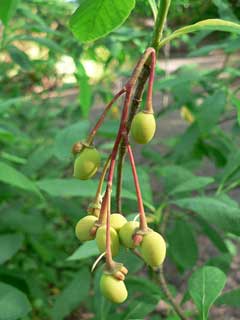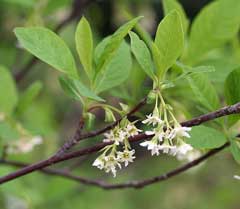 |
|
http://commons.wikimedia.org/wiki/User:Wsiegmund |
 |
| http://de.wikipedia.org/wiki/Benutzer:Michael_w |
Translate this page:
Summary
Physical Characteristics

 Oemleria cerasiformis is a deciduous Shrub growing to 2.5 m (8ft) by 4 m (13ft).
Oemleria cerasiformis is a deciduous Shrub growing to 2.5 m (8ft) by 4 m (13ft).
See above for USDA hardiness. It is hardy to UK zone 6. It is in flower from March to April. The species is dioecious (individual flowers are either male or female, but only one sex is to be found on any one plant so both male and female plants must be grown if seed is required). and is pollinated by Insects. The plant is not self-fertile.
Suitable for: light (sandy), medium (loamy) and heavy (clay) soils and prefers well-drained soil. Suitable pH: mildly acid, neutral and basic (mildly alkaline) soils. It can grow in semi-shade (light woodland). It prefers moist soil.
UK Hardiness Map
US Hardiness Map
Synonyms
Nuttallia cerasiformis. Osmaronia cerasiformis.
Plant Habitats
Woodland Garden Dappled Shade; Shady Edge;
Edible Uses
Edible Parts: Fruit
Edible Uses:
Fruit - raw or cooked[46, 61, 118, 183]. A poor flavour[106]. The fruit looks like a small plum but is very bitter with an almond flavour[11]. The fully ripe fruit loses most of its bitterness[256]. The fruit only has a thin layer of flesh[200]. The fruit can be dried and stored for winter use[257]. Some caution is advised, see the notes above on toxicity.
References More on Edible Uses
Medicinal Uses
Plants For A Future can not take any responsibility for any adverse effects from the use of plants. Always seek advice from a professional before using a plant medicinally.
Laxative Poultice TB
The bark is mildly laxative[257]. A decoction has been used in the treatment of tuberculosis[257]. A poultice of the chewed burned plant, mixed with oil, has been used to treat sore parts of the body[257].
References More on Medicinal Uses
The Bookshop: Edible Plant Books
Our Latest books on Perennial Plants For Food Forests and Permaculture Gardens in paperback or digital formats.

Edible Tropical Plants
Food Forest Plants for Hotter Conditions: 250+ Plants For Tropical Food Forests & Permaculture Gardens.
More

Edible Temperate Plants
Plants for Your Food Forest: 500 Plants for Temperate Food Forests & Permaculture Gardens.
More

More Books
PFAF have eight books available in paperback and digital formats. Browse the shop for more information.
Shop Now
Other Uses
References More on Other Uses
Cultivation details
Succeeds in an ordinary well-drained garden soil[11, 200], but becomes chlorotic on shallow soils over chalk[200]. Prefers a well-drained moisture retentive soil in a shady position[200]. Requires a sunny position according to another report[182]. Plants are hardy to about -20°c[184]. This species grows well in a woodland garden or in a damp shady border[200]. The plants often sucker freely and can form dense thickets[188]. Old plants can be rejuvenated by cutting them back hard into the old wood in late winter, they will resprout freely from the base[200]. Growth can be restricted by removing suckers and cutting old shoots back or down to the base in late winter[188]. Some, if not all plants are dioecious. Male and female plants must be grown if seed is required.
References Carbon Farming Information and Carbon Sequestration Information
Temperature Converter
Type a value in the Celsius field to convert the value to Fahrenheit:
Fahrenheit:
The PFAF Bookshop
Plants For A Future have a number of books available in paperback and digital form. Book titles include Edible Plants, Edible Perennials, Edible Trees,Edible Shrubs, Woodland Gardening, and Temperate Food Forest Plants. Our new book is Food Forest Plants For Hotter Conditions (Tropical and Sub-Tropical).
Shop Now
Plant Propagation
The seed requires 4 months stratification at 4°c. It is probably best sown in a cold frame as soon as it is ripe in the autumn. Sow stored seed as early in the year as possible. When they are large enough to handle, prick the seedlings out into individual pots and grow them on in the cold frame for at least their first winter. Plant them out into their permanent positions in late spring or early summer, after the last expected frosts. Cuttings of half-ripe wood, July/August in a frame. Layering in spring. Takes 6 months[78]. Suckers, taken at any time in the dormant season[188].
Other Names
If available other names are mentioned here
Native Range
NORTHERN AMERICA: Canada (British Columbia (south)), United States (Oregon (west), Washington (west), California (north))
Weed Potential
Right plant wrong place. We are currently updating this section.
Please note that a plant may be invasive in one area but may not in your area so it's worth checking.
Conservation Status
IUCN Red List of Threatened Plants Status :

Growth: S = slow M = medium F = fast. Soil: L = light (sandy) M = medium H = heavy (clay). pH: A = acid N = neutral B = basic (alkaline). Shade: F = full shade S = semi-shade N = no shade. Moisture: D = dry M = Moist We = wet Wa = water.
Now available:
Food Forest Plants for Mediterranean Conditions
350+ Perennial Plants For Mediterranean and Drier Food Forests and Permaculture Gardens.
[Paperback and eBook]
This is the third in Plants For A Future's series of plant guides for food forests tailored to
specific climate zones. Following volumes on temperate and tropical ecosystems, this book focuses
on species suited to Mediterranean conditions—regions with hot, dry summers and cool, wet winters,
often facing the added challenge of climate change.
Read More
Expert comment
Author
(Torr.&A.Gray.)Greene.
Botanical References
1160200
Links / References
For a list of references used on this page please go here
Readers comment